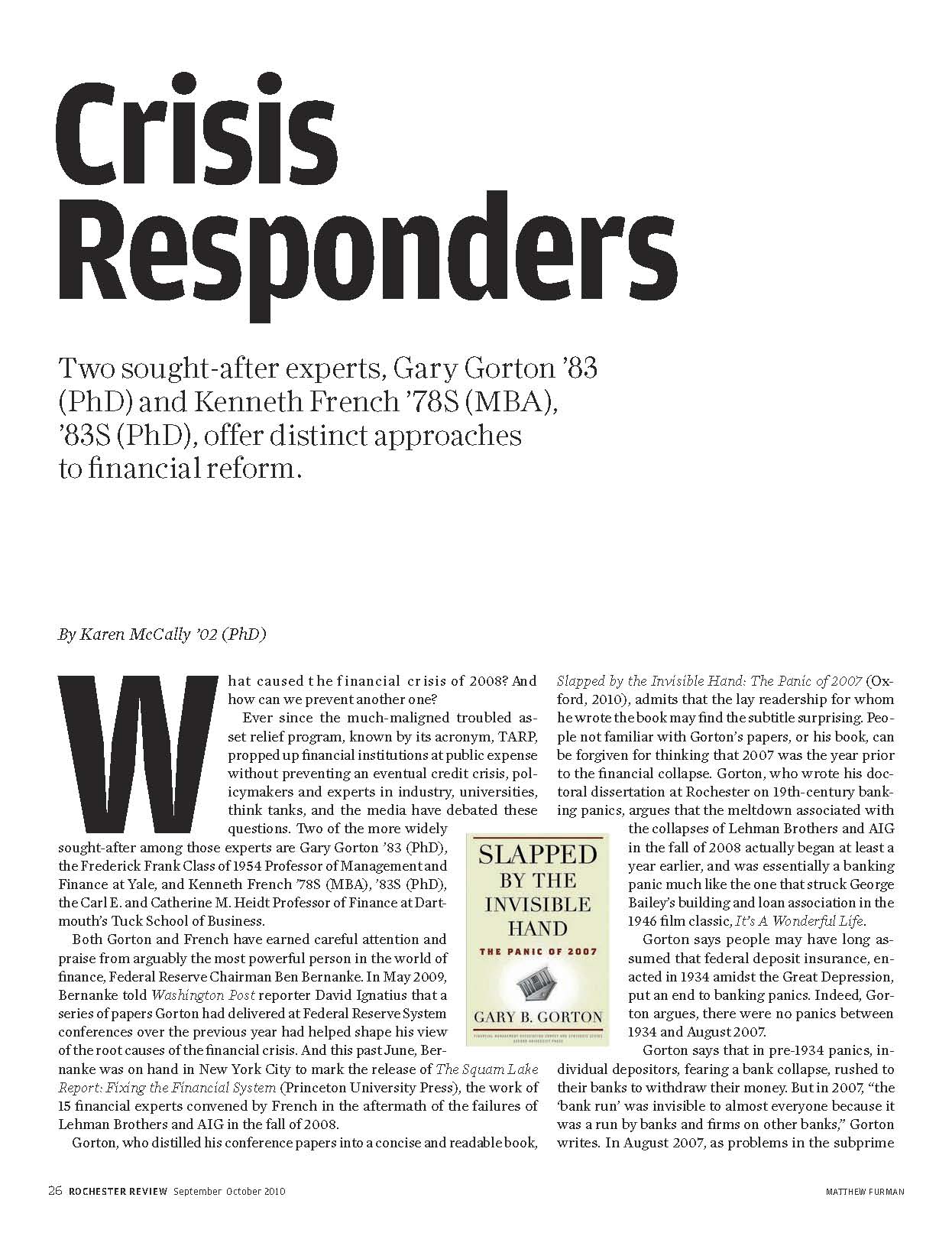Features
What caused the financial crisis of 2008? And how can we prevent another one?
Ever since the much-maligned troubled asset relief program, known by its acronym, TARP, propped up financial institutions at public expense without preventing an eventual credit crisis, policymakers and experts in industry, universities, think tanks, and the media have debated these questions. Two of the more widely sought-after among those experts are Gary Gorton ’83 (PhD), the Frederick Frank Class of 1954 Professor of Management and Finance at Yale, and Kenneth French ’78S (MBA), ’83S (PhD), the Carl E. and Catherine M. Heidt Professor of Finance at Dartmouth’s Tuck School of Business.
Both Gorton and French have earned careful attention and praise from arguably the most powerful person in the world of finance, Federal Reserve Chairman Ben Bernanke. In May 2009, Bernanke told Washington Post reporter David Ignatius that a series of papers Gorton had delivered at Federal Reserve System conferences over the previous year had helped shape his view of the root causes of the financial crisis. And this past June, Bernanke was on hand in New York City to mark the release of The Squam Lake Report: Fixing the Financial System (Princeton University Press), the work of 15 financial experts convened by French in the aftermath of the failures of Lehman Brothers and AIG in the fall of 2008.
 ROOT CAUSE: Financial reform has yet to address the root cause of the financial crisis, says Gorton. (Photo: Matthew Furman)
ROOT CAUSE: Financial reform has yet to address the root cause of the financial crisis, says Gorton. (Photo: Matthew Furman)Gorton, who distilled his conference papers into a concise and readable book, Slapped by the Invisible Hand: The Panic of 2007 (Oxford, 2010), admits that the lay readership for whom he wrote the book may find the subtitle surprising. People not familiar with Gorton’s papers, or his book, can be forgiven for thinking that 2007 was the year prior to the financial collapse. Gorton, who wrote his doctoral dissertation at Rochester on 19th-century banking panics, argues that the meltdown associated with the collapses of Lehman Brothers and AIG in the fall of 2008 actually began at least a year earlier, and was essentially a banking panic much like the one that struck George Bailey’s building and loan association in the 1946 film classic, It’s A Wonderful Life.
Gorton says people may have long assumed that federal deposit insurance, enacted in 1934 amidst the Great Depression, put an end to banking panics. Indeed, Gorton argues, there were no panics between 1934 and August 2007.
Gorton says that in pre-1934 panics, individual depositors, fearing a bank collapse, rushed to their banks to withdraw their money. But in 2007, “the ‘bank run’ was invisible to almost everyone because it was a run by banks and firms on other banks,” Gorton writes. In August 2007, as problems in the subprime mortgage market emerged, banks and firms rushed to redeem their money. Multibillion dollar federal bailouts staved off collapse but could not induce banks to begin lending again. The result was a widespread credit crisis.
Gorton fears that the invisibility of the 2007 panic has led people to focus on the effects of the run rather than its cause, or simply to confuse the effects—such as the global credit crisis—with the cause. And that, he says, has led policymakers astray. In particular, the financial reform legislation that Congress spent over a year putting together—and that President Obama signed into law on July 21—“has nothing much to do with what happened in the crisis.”
“What they ended up doing combines disconnected ideas each of which on its own might be OK, but none of this actually has anything to do with the vulnerability of the repurchase market to runs.”
French agrees—up to a point. A recipient of the Rochester Distinguished Scholar Award in 2005 and a Distinguished Alumnus Award this past May, French put together an elite group of economic thinkers, diverse in experience and viewpoints, in November 2008, and invited them to meet for a weekend at New Hampshire’s Squam Lake to begin crafting recommendations for long-term regulatory reform. Among the members of the group were faculty from the economics departments and business schools of Yale, Columbia, Chicago, Harvard, and other universities, each bringing experience in the Federal Reserve, the National Bureau of Economic Research, and other policy arenas in addition to academic expertise.
In the ensuing months, the Sqaum Lake Working Group began releasing a series of papers, condensed into the final published report. French says he agrees that the financial system suffered a classic banking panic in the summer of 2007, calling Gorton’s ideas “absolutely critical” to understanding the crisis. “Gary’s ideas are percolating through, and I think as time goes on, he’s winning more and more converts,” says French.
“I’m not someone who thinks there was just one cause of the financial crisis,” he says. “The analogy I use is an airplane crash. Usually, it’s a combination of seven or 10 different things, where if you pulled any one or two of them out, you’d come back and say that the plane wouldn’t have crashed except that all of these elements happened simultaneously.”
While Gorton has identified one of the central factors in the financial crisis, there are others, says French. “What Gary would say is the root cause was there five years ago, and yet we didn’t have a financial crisis.”
 MULTI-CAUSAL: French says there are multiple causes of the financial crisis—“and the more problems you can eliminate, the better off you are.” (Photo: Michael J. Maloney)
MULTI-CAUSAL: French says there are multiple causes of the financial crisis—“and the more problems you can eliminate, the better off you are.” (Photo: Michael J. Maloney)To French, the crisis resulted from a combination of misplaced incentives and the false assumptions that guide the regulatory system. His thematic approach is reflected in the Squam Lake Group’s recommendations, which are organized around two central concerns. The first is that regulations be shaped not just to ensure the soundness of individual firms, but to address the risk that any given firm poses to the entire financial system. The second is that the firms themselves—rather than the U.S. Treasury—be able to cover the costs of failure. Among the recommendations is the establishment of a systemic regulator in each country (the group recommends that it be the central bank) to analyze and report on systemic risk and design and implement regulations to ensure systemic stability. To ensure that financial institutions bear the costs of failure, the group recommends the equivalent of corporate “living wills”—a plan to dissolve the institution, subject to ongoing regulatory scrutiny. Other recommendations include deferred compensation to executives, new capital requirements, and new disclosures and rules to protect retirement savings.
Gorton likes some elements of the The Squam Lake Report, but on the whole, calls it “unfocused.” “It ends up proposing many things—things which are good—but while we do that, let’s solve the problem as well.”
That problem, Gorton maintains, is how to preserve, albeit more securely, what he calls the “shadow banking system,” in which firms and institutional investors deposit large amounts of money in commercial or investment banks as a means to achieve safe and easy access and a measure of interest (like a “checking account for firms,” Gorton calls it). The shadow banking system evolved in the past 30 years to address, among other things, a collateral shortage, Gorton says. But as commercial and institutional investors reuse collateral in the form of securitized loans, this shadow banking system is vulnerable to runs.
Rather than grant the Federal Reserve the function of systemic regulation, as the Squam Lake Group proposes, Gorton would like to see a new kind of bank—highly restricted “narrow funding banks”—to perform the functions of the shadow banking system under regulatory scrutiny. He’s working on a new paper for the Brookings Institution, coauthored with his Yale colleague Andrew Metrick, to detail such a plan.
“We want to recognize the shadow banking system as a real banking system, a system that’s worth preserving,” he says.
Both Gorton and French stress that the passage of financial reform legislation this summer is the beginning, rather than the end, of efforts to reform the financial system. Gorton believes new legislation will still be necessary. And no changes will occur until regulators write thousands of rules to implement what are, in many cases, general outlines and broad principles outlined by Congress in the legislation.
“There’s enormous discretion left to the regulators,” says French. And the person to watch will be whoever President Obama selects to head the newly created consumer protection agency.
That person “is going to be one of the most powerful people in the country,” he says. “They’re going to really set the precedent for what that agency’s about, what they do, how they tackle the issues, how they think about trade-offs, and the Wall Street folks are spending enormous resources trying to weigh in on that.”

